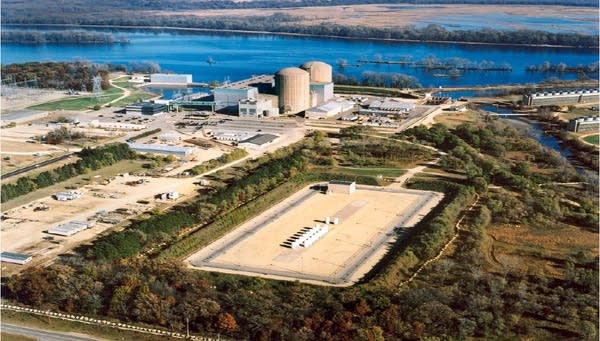Neighbors share concerns about Prairie Island nuclear plant
Go Deeper.
Create an account or log in to save stories.
Like this?
Thanks for liking this story! We have added it to a list of your favorite stories.

Xcel Energy wants to boost its Prairie Island plant's generating capacity by increasing the heat generated by the two nuclear reactors, and capturing the added heat with improved equipment.
Xcel also wants permission to store on-site an additional 35 casks of spent nuclear fuel. That would allow continued plant operations through 2034. Currently, 24 casks are stored on-site.
The state is reviewing both questions, along with a site permit, in a single process.
The recession has prompted Xcel to reduce its estimate of how much power will be needed in coming years. But Xcel's director of nuclear regulatory policy, Terry Pickens, said in an interview before the meeting that demand will eventually pick up, and nuclear power is still the best choice.
Turn Up Your Support
MPR News helps you turn down the noise and build shared understanding. Turn up your support for this public resource and keep trusted journalism accessible to all.
"When we put this though our resource planning model, it takes a look at the various alternatives available, and Prairie island shows the least expensive option for us to take," Pickens said.
But most of the 35 or so people at the meeting weren't convinced of the need for more power, and said they had plenty of reasons for thinking if more power is needed, it shouldn't be produced at the nuclear plant in their backyard.
Everyone who spoke said the draft Environmental Impact Statement prepared by the state's Office of Energy Security was inadequate. The environmental review is supposed to study possible impacts of the project, and to examine alternatives.
What's in those casks is very dangerous; we're talking about stuff that has to be kept completely out of the environment
George Crocker runs the North American Water Office, an environmental group that watch-dogs utility issues. He said the report minimizes the risk of radiation exposure for people living near the plant.
"The National Academies of Science says there is no safe dose," Crocker said. "The radionuclides that will be and are being and will continue to be released at Prairie Island will continue to biologically active on into the distant future. Your document has an obligation to take that full impact into account."
Others pointed to President Obama's declaration that the planned permanent repository for nuclear waste at Yucca Mountain in Nevada isn't going to work. They said that means the casks of spent fuel currently sitting on a concrete pad at Prairie Island will become permanent.
Roger Cuthbertson said that's not acceptable.
"What's in those casks is very dangerous; we're talking about stuff that has to be kept completely out of the environment and out of reach of animals and people for thousands and thousands of years," Cuthbertson said. "I mean it's like having a party on Saturday night and then having people clean up after your party for 35 years. It's crazy."
He earned a smattering of applause with that speech.
Two members of the Prairie Island Indian Community talked about the stresses that come with living so close to the plant.
Nuclear power is gaining favor among some because the plants don't produce greenhouse gases that can alter the climate.
But a former mayor of nearby Lake City, Katie Himanga, said the environmental report shouldn't describe nuclear power as carbon-free. After the meeting, she said nuclear energy should be only compared with other sources of power by counting greenhouse gas emissions throughout the full life-cycle of the generating system.
"There most certainly would be carbon emissions associated with the mining of the raw material and the transportation of that material to the plant, and then the management and handling of the waste from the time it's taken from the reactors until the time it is safe, which as we know would be many thousands of years," Himanga said.
Another critic, Kristen Eide-Tollefson, said the environmental impact statement, or EIS, is like a cost-benefit analysis that's weighted in favor of the project.
"The preparers of the EIS have put all these benefits on the scale: it's cheap, it doesn't emit CO2," Eide-Tollefson said. "But they've scoped out of the environmental report, they haven't allowed into the environmental report any analysis of the costs."
One reason some of that analysis is not in the study is that the federal government has jurisdiction over issues like plant safety and operation.
It's up to the state to decide whether it's in the public interest to produce more power and store more waste.
A federal review is underway, but the results won't be available until June.
The Prairie Island Indian Community has asked for a delay in the state process, so the information from the federal review could be included. But Minnesota law requires the state to make a decision within a year of the date the application is made, which was last July.
The comment period is open until May 8th, with a public hearing scheduled for May 14th.



